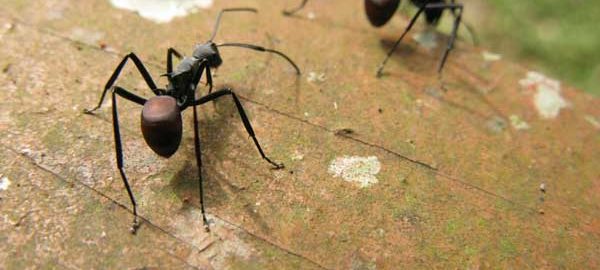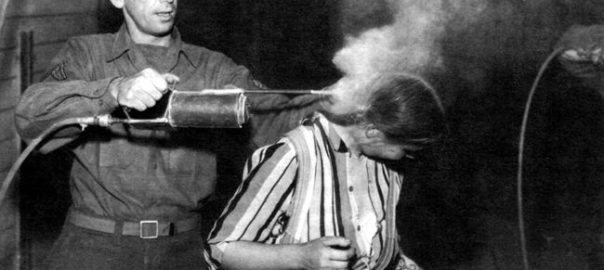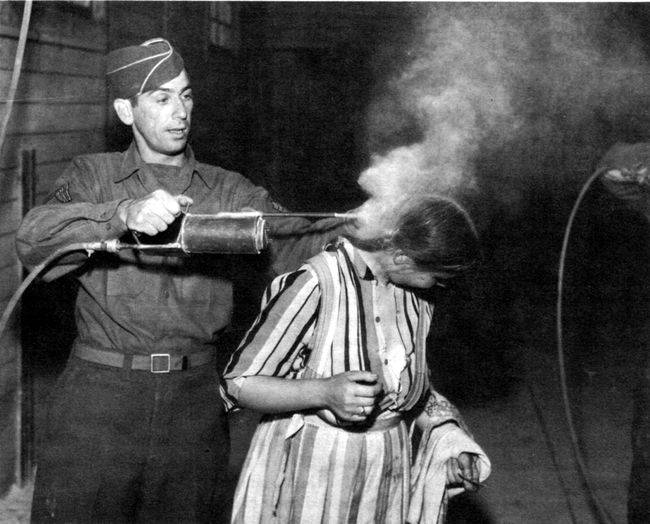So, you have an ant problem and you want to make it go away in a humane, natural way?
Kudos to you for not wanting to use harsh chemicals that hurt or kill them. By doing using so you will be protecting the environment, your kids, pets, and your own consciousness.
Whether you are a Buddhist, animal lover, PETA enthusiast, or just in favor of natural solutions, getting rid of ants in the house naturally without poisons is possible.
An effective, environmentally safe approach consists of the following steps.
- Hide ant tracks that function as scent trails
- Prevent access by sealing off entrances to your home
- Collect ants inside the house
- Prevent ants from returning by using natural repellents
- If necessary, use baits
The first way to get rid of ants without killing them is to simply use preventative methods.
Be alarmed when you should
Seeing ants in your kitchen should mean seeing a big red flag. Here’s why.
There are three types of jobs in an ant colony, the queen, soldiers, and scouts.
Most ant species employ scouts roaming for food sources. When stumbled upon food they recruit other colony members to join the invasion.
As long as there’s food to be found there will be ants, and more of them for that matter too.
Which ant type?
It can be helpful to determine with which type of ants you are dealing. Basically there are 3 types:
- Argentine ants (house ants)
- Carpenter ants
- Fire ants
Read this Mother Nature Network post to find out which ant species is in your home.
Just don’t feed them
Ants are attracted to tasty, sticky, sweet, and sticky things objects. This generally means that the first place you will notice an ant problem is in the kitchen.
The easiest way to ensure cleanliness and preventing ants would be to clean or put away all dirty dishes before you go to sleep.
Also make sure all food items on the counters (sugar container, condiments, etc.) are wiped down and aren’t leaving any residue behind, and to wipe up spills immediately so they can’t leave any scents for the ants to pick up.
- Make sure your counter-tops are clean and free of food particles that might draw ants.
- If ants are in your cupboards or pantry, clean those areas, too.
- Make sure there are no open food containers or packages for them to crawl into.
- Rinse off bottles, jars, and other container that have residue on the exterior. Honey and syrup, jam and jelly jars can be genuine ant magnets.
- Keep all foods in sealed in containers (at least for about a week until the ants are gone).
- Keep the kitchen trash container frequently emptied and shut tightly.
- Keep in mind that ants may be lured in by fragranced cleaning products too. Seal theses off too or (temporarily) store somewhere else.
Pro tip: cleaning surfaces with vinegar is not only an eco-friendly, money-saving and effective option, it also repels ants.
But what should you do if you already have ants or those preventative methods didn’t work?
Hide scent trails
Ants leave a scented trail so other ants can find their way to food. You can throw them off by washing away these invisible trails with soapy water.
- Don’t spray directly on the ants as this will kill them.
Ants give off a scent wherever they go. This is why you find that large groups of ants gather in certain areas. Besides water and soap you are able to hide this scent with a borax and water mix and certain essential oils.
Ant trails get stronger as more ants follow the path. This continues until the food is gone after which the trail dissipates.
All-natural ways to cover ant trails
- Make a vinegar-based solution using 1/4 cup vinegar, 2 cups water and 10 to 15 drops of peppermint, clove, Eucalyptus or Melaleuca essential oil. The vapors from the vinegar and essential oils will confuse their senses.
- Peppermint Essential Oil – This is a fantastic oil for concealing ant trails and it smells great too. To use this, simply put a few drops on a cotton ball and wipe down areas that you believe ants could possibly get into – or places where you already have ants. Or leave the ant balls at strategical locations to keep them out.
Bonus Fact! – This oil also keeps the spiders away – they hate peppermint!
- Tea Tree Essential Oil – This works the same way as the peppermint oil – just put some on a cotton ball and wipe down ant entrances/infested areas.
- Borax – can be used to remove ant trails after the ants have been removed humanely. Borax (sodium tetraborate) has been mined for over 4000 years. It’s a naturally occurring mineral found in dried salt lake beds.
- For Ants in Pet Food Bowls. If your pet food bowls keep attracting ants, you can take a shallow dish or pan that is slightly wider than your pet’s food bowl, fill it with soapy water, and center the food bowl in the dish. This creates a moat around the food bowl that the ants will be unable to cross.
Keep em out, prevent access to your home
Find out where the ants manage to get in (you’re the scout now). Once you’ve found the access point(s) i.e.
Identify entrance locations (antrances). Do some searching around your home for any areas that may be cracked near the floor and use a sealer, such as caulk, glue, putties or plaster to close off the area.
Seal off every entrance hole you can find with putty, plaster, glue, silicone caulk, or by renewing boards or updating construction.
- Don’t have these at hand? Use Vaseline, some of the kids clay, or another substance as a temporary solution.
Collect and dispose
The last way you can get rid of ants without killing them is to collect the ones found in your home and dispose of them outdoors.
To do this, it would be best to locate the area with ants, put a plate or something similar on the ground near them and garnish the plate with something the ants can’t resist such as, sugar water or honey.
Once the ants have gathered on the plate, take it outside and dispose of it. Follow-up with the two methods above to assure that no more ants can infest your home after removing them this way.
A way to collect small numbers of ants is as follows:
- Use a damp piece of paper towel or a cotton ball
- Gently dab individual ants with the damp paper.
- Insert the damp paper towel inside an air-tight jar that has a little sugar on the bottom (this helps keep the ants at the bottom of the jar)
- Empty the jar outside and away from the home
Prevent ants from returning
By using natural repellents/ deterrents such as;
FightDiscourage them with cucumber. Ants have an aversion to cucumbers, and either sliced cucumber or peel scrapings can be placed near the point of entry for ants into your house to help deter them from coming in.
- Herbs and essential oils. Leave a few bags of mint tea where ants tend to congregate. Cayenne pepper, citrus oil, lemon juice, cinnamon, coffee grounds—all have some deterrent properties against ants. Placed near their point of entry, it might cause them to go back from where they came.
- Shine a light on them. Find the ants’ entry point and leave a small light bulb shining on this area. The change in light can disrupt and discourage their foraging patterns.
A very popular natural insect repellent commonly used to keep ants away is Majestic Pure Therapeutic Grade Peppermint Essential Oil.
- Read its reviews to learn how it helped de-ant people’s homes.
- It’s claimed to help you keep fleas, spiders, mice, rodents and roaches away as well.
Other commonly used natural ant barriers include:
- Chalk
- Powdered charcoal
- Desiccating dusts, i.e. Diatomaceous earth
- Cinnamon (i.e. sticks or powder)
- Turmeric
- Garlic
- Hot pepper such as red chili pepper (the hotter the better)
- Powdered cleanser
- Coffee grinds
- Paprika
- Cloves
- Orange Guard is a non-toxic commercial insecticide that can be used to repel ants. Make sure to not spray the ants directly as this will suffocate (kill) them.
Use baits
If all of these remedies don’t suffice you can always resort to more invasive methods such as baits and traps.
Commonly, however, these all-natural ways to get rid of ants work wonders if applied regularly and methodically.
A risky method: feed ants
Folkore asserts that you can prevent ants from entering your home by giving them what they want outside the home.
By providing them with syrup or perhaps more natural foods away from the house you can take away their urge to invade your house.
At least, that’s the premise. Whether this controlled feeding method is an old wives’ tale or not remains to be seen.
You may run the risk of giving the ant colony population a boost creating even more hungry soldiers ready to maraude your kitchen. Personally, I would not try this at home (or near the home for that matter).
Common sense may cause one to think that more food simply means more ants.
In sum
Natural remedies for getting rid of ants are becoming more and more popular and there are a number of things you can do in order to prevent ants in your home.
By now, you should have a great understanding of the different ways you can get rid of ants without killing them.
The best way to secure an ant-free home is to use a combination of the above mentioned methods together in order to live without ants. So you can live in harmony with nature. Each species on its own turf.
Share your humane, non-toxic ant control experiences
How did you try to get rid of ants without using harsh chemicals? Did you manage or are you still struggling? Ask questions, give tips, share your findings by dropping a comment below.
You may also like


